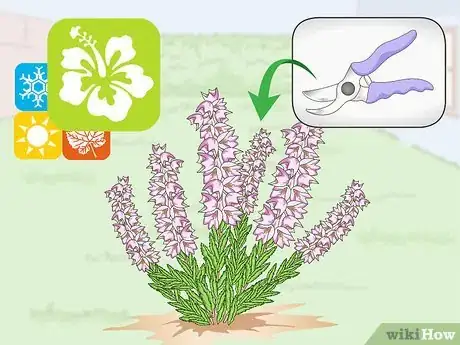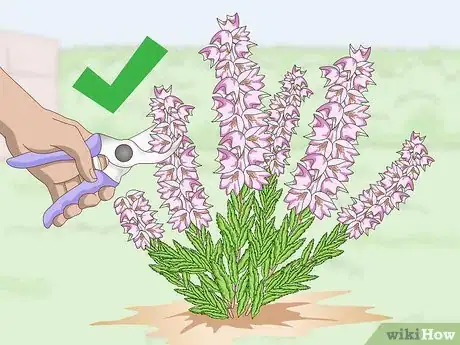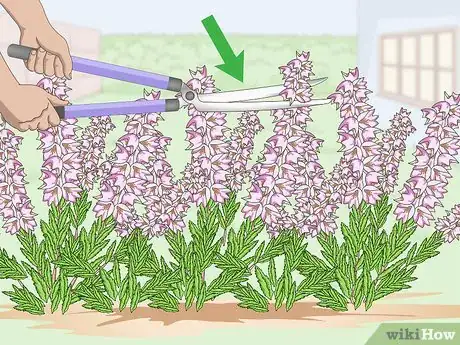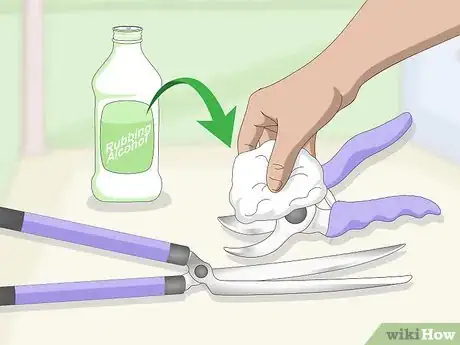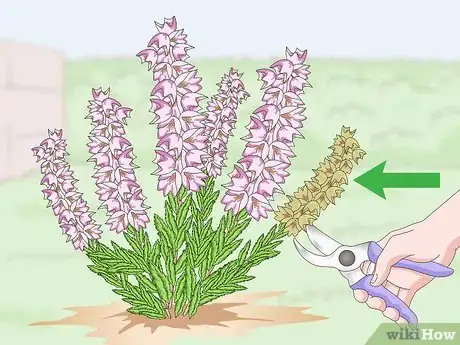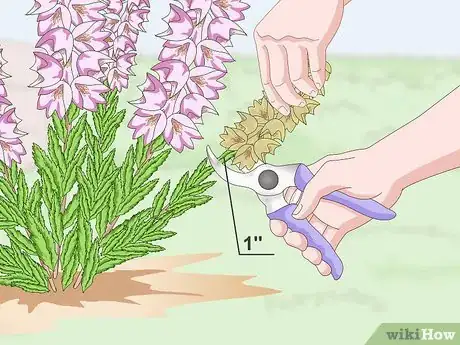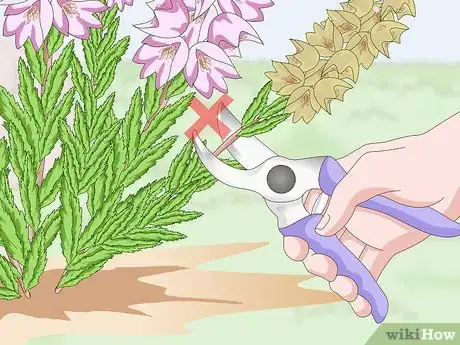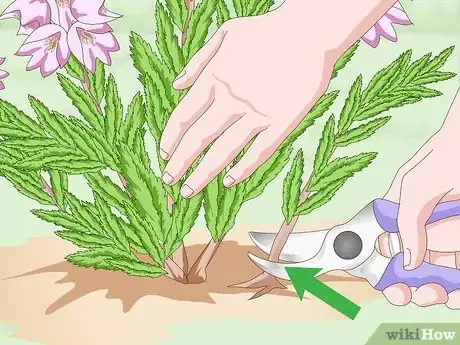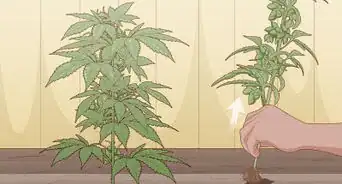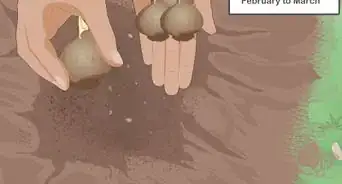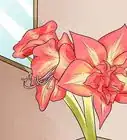This article was co-authored by Maggie Moran and by wikiHow staff writer, Hunter Rising. Maggie Moran is a Professional Gardener in Pennsylvania.
There are 7 references cited in this article, which can be found at the bottom of the page.
This article has been viewed 115,559 times.
Heathers, or calluna vulgaris, are popular and resilient flowering plants that require little upkeep. At the start of their blooming seasons, heathers will continue to grow from their old, withered stems unless they are pruned. By using the right tools for the job and shaping the plant, you too can have beautiful flowers throughout the year!
Steps
Choosing the Right Time and Tools
-
1Prune annually in the early spring after the last frost. Heathers will either bloom in the winter or the summer, but it’s recommended to keep any past blooms attached throughout the winter to protect the roots. Start pruning after the risk of frost has passed so the stems of your heathers do not suffer any damage.[1]
- You can prune summer blooms in the fall if you live in a warmer climate.
- Winter heathers are cut after they have bloomed, while summer blooms are being cut before they start to grow.
- If you live in the United States, you can use your ZIP code to estimate the last expected frost date in your area here: https://garden.org/apps/frost-dates/
-
2Use hand shears for smaller heathers. Opt for shears that have a spring in them so it is less stressful on your hands. If you want to have more control over which blooms you cut, hold the bloom with your non-dominant hand and make a cut with hand shears.[2]
- Make sure your shears are sharp before you use them so you can make the cleanest cut.
Advertisement -
3Shape large beds of heather with hedge shears. Long-handled shears will work best. Hold the hedges shears near the ends of the handle to control them the easiest. Open and close the shears so they make a snapping noise with each cut.[3]
- Hedge shears can be purchased at garden and home care stores.
- For added grip, wear gardening gloves while you use the hedge shears.
-
4Disinfect your shears with rubbing alcohol before and after each plant. Rub your shears with a cloth soaked in rubbing alcohol to clean them. Repeating this process before and after each plant will prevent the spread of any disease or fungus.[4]
- You can also make a cleaning solution using 9 parts water and 1 part chlorine bleach. Soak the shears for 30 minutes before drying them off and using them.
- Heathers are resilient to most common plant diseases, but it’s still good practice to clean your gardening tools.
Trimming Heather
-
1Remove old blooms that are withered and yellow. The old blooms will be at the top and edges of your plant and are attached to green stems. Anything brown or yellow should be removed from your plant so new blooms have room to grow.[5]
-
2Make angled cuts about 1 inch (2.5 cm) below the old bloom stalks. The old blooms will look dry and withered on top of green stems. Hold the end of the dead bloom with one hand and use your shears to make an angled cut to reduce the risk of fungal infection or disease. You can remove up to one-third of the plant this way.[6]
- You don’t have to be precise with the angle you cut, as long as water is able to run off the end of the stem.
- Annual pruning will help prevent a bald spot from forming in the middle of your plant.
-
3Don’t cut into the woody area of your heathers or it will not grow back. Only make your cuts into the green stems of your plant. If you cut too far down into brown and barren wood, blooms will not regenerate from the stem.[7]
- If your plant has a bald spot, new blooms will not form in that area. Replace the entire plant if you want it to bloom fully.
-
4Lift the tops of the plant to trim the undergrowth and prevent spreading. Lift up the tops of the plant up with one hand while you cut the stems with the other. Plants that grow too close to one another will compete for resources, producing fewer blooms and possibly harming your plant.[8]
- If you don’t want heather to intrude on other plants, you can cut into woody parts of the plant to prevent it from growing in that direction.
Expert Q&A
Did you know you can get expert answers for this article?
Unlock expert answers by supporting wikiHow
-
QuestionDo lavender plants need to be cut back?
 Maggie MoranMaggie Moran is a Professional Gardener in Pennsylvania.
Maggie MoranMaggie Moran is a Professional Gardener in Pennsylvania.
Home & Garden Specialist
-
QuestionWhen should I cut back Hebe?
 Maggie MoranMaggie Moran is a Professional Gardener in Pennsylvania.
Maggie MoranMaggie Moran is a Professional Gardener in Pennsylvania.
Home & Garden Specialist
-
QuestionHow do I trim lavender bushes and when?
 Maggie MoranMaggie Moran is a Professional Gardener in Pennsylvania.
Maggie MoranMaggie Moran is a Professional Gardener in Pennsylvania.
Home & Garden Specialist
Warnings
- Bald spots and stems cut down to the brown wood base will not flush out more blooms. At that point, it’s best to replace the plant entirely.⧼thumbs_response⧽
Things You’ll Need
- Hand shears
- Hedge shears
- Gardening gloves
References
- ↑ https://www.gardenia.net/guide/how-to-grow-and-care-for-heaths-and-heathers
- ↑ https://youtu.be/2K0naiizBYk?t=7s
- ↑ https://youtu.be/wGSh2SgVt0M?t=12s
- ↑ http://gardeningsolutions.ifas.ufl.edu/care/tools-and-equipment/disinfecting-tools.html
- ↑ https://youtu.be/2K0naiizBYk?t=50s
- ↑ https://youtu.be/2K0naiizBYk?t=50s
- ↑ https://www.heathersociety.org/wp-content/uploads/2015/03/A-Beginners-Guide.pdf
- ↑ https://youtu.be/0X4aD8LIDkQ?t=1m23s
About This Article
Heathers are beautiful flowering plants that require little upkeep in your garden, but you should still prune them. Prune your heathers once a year just after the last frost of the spring. Use hand shears if your heathers are relatively small or hedge shears if you have large bushes. Remove any old blooms that are withered and yellow. These will usually be at the top and edges of your plant. Make angled cuts about 1 inch below the old bloom stalks to reduce the risk of infection or disease. Don’t cut into the brown, woody areas of your heathers, since these won’t grow back. For more tips from our Gardening co-author, including how to disinfect your shears to avoid infection, read on!
